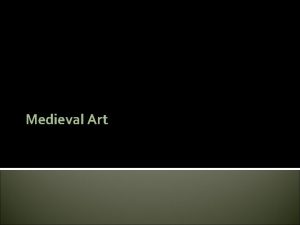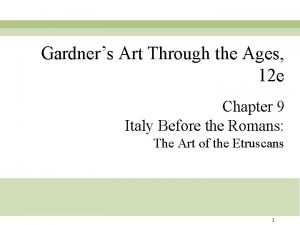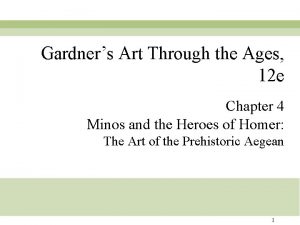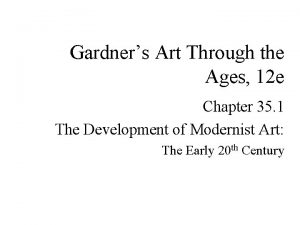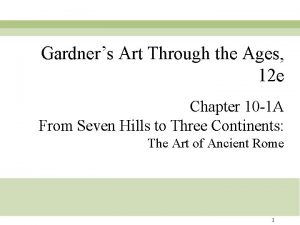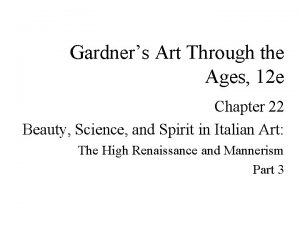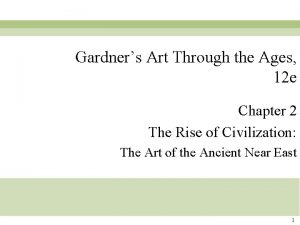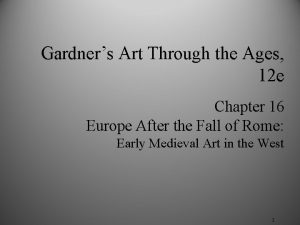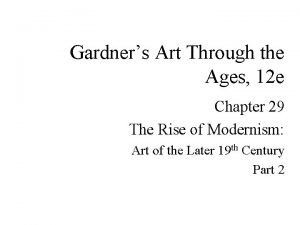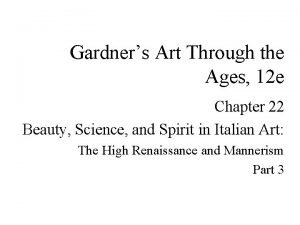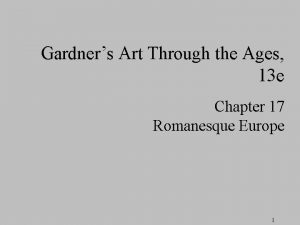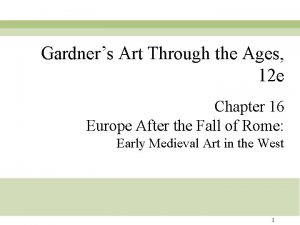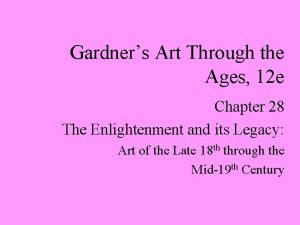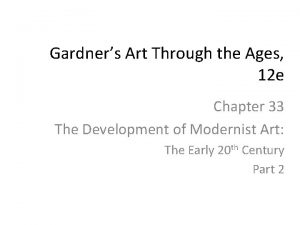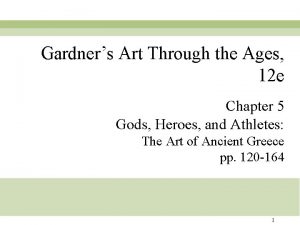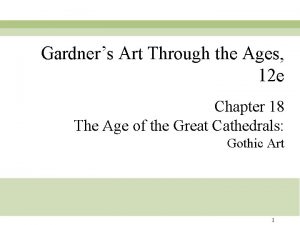Gardners Art Through the Ages 12 e Chapter

















- Slides: 17

Gardner’s Art Through the Ages, 12 e Chapter 22 Beauty, Science, and Spirit in Italian Art: The High Renaissance and Mannerism Part 2

Rome with Renaissance and Baroque Monuments

MICHELANGELO • Michelangelo’s versatility in the disciplines he took up was of such a high order that he is often considered a contender for the title of the archetypal Renaissance man, along with his rival and fellow Italian Leonardo da Vinci. • Michelangelo's output in every field during his long life was prodigious; when the sheer volume of correspondence, sketches, and reminiscences that survive is also taken into account, he is the best-documented artist of the 16 th century. Two of his best-known works, the Pieta and David, were sculpted before he turned thirty. Despite his low opinion of painting, Michelangelo also created two of the most influential works in fresco in the history of Western art: the scenes from Genesis on the ceiling and The Last Judgment on the altar wall of the Sistine Chapel in Rome.

In the Pietà, Michelangelo approached a subject which until then had been given form mostly north of the Alps, where the portrayal of pain had always been connected with the idea of redemption. The twenty-three year-old artist presents us with an image of the Madonna with Christ's body never attempted before. Her face is youthful, yet beyond time; her head leans only slightly over the lifeless body of her son lying in her lap. "The body of the dead Christ exhibits the very perfection of research in every muscle, vein, and nerve. No corpse could more completely resemble the dead than does this. There is a most exquisite expression in the countenance. The veins and pulses, moreover, are indicated with so much exactitude, that one cannot but marvel how the hand of the artist should in a short time have produced such a divine work. “ (Vasari) Michelangelo chose to represent David before the fight contemplating the battle yet to come. It came to symbolize the defense of civil liberties embodied in the Florentine Republic, an independent city state threatened on all sides by more powerful rival states. Michelangelo's David differs from previous representations of the subject in that David is not depicted with the slain Goliath, a common interpretation is that David is depicted before his battle with Goliath. Instead of being shown victorious over a foe much larger than he, David looks tense and ready for combat. His veins bulge out of his lowered right hand the twist of his body effectively conveys to the viewer the feeling that he is in motion. The statue is meant to show David after he has made the decision to fight Goliath but before the battle has actually taken place. It is a representation of the moment between conscious choice and conscious action.

MICHELANGELO BUONARROTI, The Pieta, 1499, Marble, the Vatican, Rome.

MICHELANGELO BUONARROTI, David, 1501– 1504. Marble, 13’ 5” high. Galleria dell’Accademia, Florence.

Alternate View Full figure, 3/4 length, seen from the right © 2005 Saskia Cultural Documentation, Ltd.

Originally intended for St. Peter’s Basilica, "Moses" and the pope’s tomb were instead placed in a church patronised by the della Rovere family from which Pope Julius came. MICHELANGELO BUONARROTI, Moses, San Pietro in Vincoli, Rome, Italy, ca. 1513– 1515. Marble, approx. 8’ 4” high.

The statue depicts Moses with horns on his head. This is based on a literal translation of the Latin Vulgate of Exodus 34: 29 -35, which speak of Moses' face as having "horns, " horns being symbolic of authority in ancient Near Eastern culture. However, in both Latin and Hebrew the word for horns can also refer to rays of light. Alternate View Total view © 2005 Saskia Cultural Documentation, Ltd.

In the Bound Slave, believed to have been carved originally for Julius II's tomb, Michelangelo made the body an expression of the idea of oppression and a vehicle of intense feelings. The violent contrapposto reveals the figure's defiance and his frantic but impotent struggle against his restraints. MICHELANGELO BUONARROTI, Bound Slave, 1513– 1516. Marble, approx. 6’ 10 1/2” high. Louvre, Paris.

The Sistine Chapel • In 1506, Julius II conceived a program to paint the ceiling of the Sistine Chapel. The walls of the chapel had been decorated twenty years earlier. Michelangelo who was not primarily a painter but a sculptor, was reluctant to take on the work. Also, he was occupied with a very large sculptural commission for the Pope’s own tomb. The Pope was adamant, leaving Michelangelo no choice but to accept. • Michelangelo conceived the scheme for the ceiling which eventually comprised some three hundred figures and took four years to execute, being completed in 1512. In order to reach the chapel's ceiling, Michelangelo designed his own scaffold, a flat wooden platform on brackets built out from holes in the wall near the top of the windows, rather than being built up from the floor which would have involved a massive structure and would have meant that the chapel was unavailable for

Interior of the Sistine Chapel (view facing east), Vatican City, Rome, Italy, built 1473.

The bright colors and broad, cleanly defined outlines make each subject easily visible from the floor. Despite the height of the ceiling the proportions of the Creation of Adam are such that when standing beneath it, "it appears as if the viewer could simply raise a finger and meet those of God and Adam". (Vasari) MICHELANGELO BUONARROTI, ceiling of the Sistine Chapel, Vatican City, Rome, Italy, 1508– 1512. Fresco, approx. 128’ x 45’.

MICHELANGELO BUONARROTI, Creation of Adam (detail), ceiling of the Sistine Chapel, Vatican City, Rome, Italy, 1511– 1512. Fresco, approx. 9’ 2” x 18’ 8”.

MICHELANGELO BUONARROTI, The Downfall of Adam and Eve and their Expulsion from the Garden of Eden, ceiling of the Sistine Chapel, Vatican City, Rome, Italy, 1511– 1512. Fresco, approx. 9’ 2” x 18’ 8”. The overt subject matter of the ceiling is the doctrine of humanity’s need for Salvation as offered by God through Jesus. It is a visual metaphor of Humankind's need for a covenant with God. The old covenant of the Children of Israel through Moses and the new covenant through Christ had already been represented around the walls of the chapel.

Cleaning of ceiling of Sistine Chapel, Vatican City, Rome, Italy, 1977– 1989.

Detail of the Azor-Sadoch lunette’s left side over one of the Sistine Chapel windows at various stages of the restoration process, Vatican City, Rome, Italy, 1977– 1989. Copyright © Nippon Television Network Corporation, Tokyo.
 Howard gardners theory of multiple intelligences
Howard gardners theory of multiple intelligences Gardners multiple intelligence test
Gardners multiple intelligence test Why are the middle ages called the dark ages
Why are the middle ages called the dark ages Renaissance vs medieval art
Renaissance vs medieval art Chapter 7 early childhood ages 3 through 5
Chapter 7 early childhood ages 3 through 5 Literary archetypes
Literary archetypes Technology through the ages
Technology through the ages Art has been an integral part in european history.
Art has been an integral part in european history. Middle ages art characteristics
Middle ages art characteristics Chapter 12 lesson 2 world history
Chapter 12 lesson 2 world history The great schism
The great schism By one man sin
By one man sin Tarnow fletcher furcation classification
Tarnow fletcher furcation classification Methods of timber conversion
Methods of timber conversion Night of the scorpion theme
Night of the scorpion theme Hát kết hợp bộ gõ cơ thể
Hát kết hợp bộ gõ cơ thể Frameset trong html5
Frameset trong html5 Bổ thể
Bổ thể








